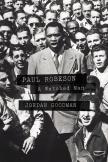Mirror to America
Successful political biographies offer insight both on their individual subject and the time in which that person lived. More rare is the biography that teaches something about who we are as Americans. Jordan Goodman’s latest biography, written with the subtlety and humility befitting a black renaissance man, lifts a mirror to America.
As red-baiting and racism reveal their ugly heads in unrelenting criticism of the first black U.S. president, Goodman reminds us how a deadly alliance between anti-communism and racism, although it ultimately failed to deter Paul Robeson, strangled the American racial and political imagination by failing to attend to the wisdom of black radical politics in the 20th century.
Tracking multiple paper trails through Canadian, U.S. and U.K. archives and special collections, Goodman weaves a compelling narrative that complements a growing body of history “from below.”
W. E. B. Du Bois, who would later become Robeson’s mentor, dear friend, comrade for Pan African rights and passionate advocate, first heralded Robeson as an outstanding scholar athlete at Rutgers University through an essay for The Crisis, the journal of the National Association for the Advancement of Colored People. Suffering racism at every turn, Robeson became an all-American football player and the valedictorian of his class of 1919. A devoted student of culture and language, he would eventually sing in 20 languages.
After the bombing of the Basque town Guernica, with its defenseless civilian population, in 1937 during the Spanish Civil War, when Robeson sang to procure relief aid for refugees and children, he changed the words of “Ol’ Man River” from “I must keep rollin’ along,” to “I must keep strugglin’ til I’m dyin.’” Robeson was unswerving in his commitment to justice by seamlessly and defiantly sewing art and politics to bind the dignity and rights of oppressed people everywhere.
For the U.S. government, art was fine so long as it was innocuous, or better, promoted America’s image. Indeed, the United States promoted African-American artists abroad, as long as they kept to their art. When the U.S. government withheld Robeson’s passport, the aim was not only to silence Robeson’s global voice, it was to discredit his American identity.
As independence movements and new nations burgeoned globally, Goodman recounts how the United States, the United Kingdom and the Soviet Union were all building the cornerstones of the Cold War.
Meanwhile, Senator Joseph McCarthy, though not the only or principal person, created the anti-Communist hysteria of the era. President Harry S. Truman issued Executive Order No. 9835 on March 21, 1947, a set of procedures and requirements used to determine whether or not civil service employees were loyal to the United States. The Truman loyalty program, as it became known, gleaned information from a variety of sources, including the Federal Bureau of Investigation and the Justice Department.
The U.S. attorney general’s role included the creation of a blacklist of groups designated as “subversive, or communist.” According to Attorney General Tom Clark, of the 12 organizations listed as subversive, only the Ku Klux Klan was not named a Communist front. Sadly, yet unsurprisingly, most of the remaining organizations named “subversive” were groups advocating human rights in the United States, Spain or South Africa.
Although the U.S. Senate eventually censored Joseph McCarthy in 1954, the State Department, the Justice Department and the F.B.I. undertook a massive propaganda campaign against Communism. Businesses like the Columbia Broadcasting System followed suit, requiring its 2,500 employees to prove their patriotism and answer whether or not they associated with or participated in any of the “subversive” groups listed by the Justice Department.
In addition to wreaking havoc in Robeson’s life, that anti-Communist dragnet would tear apart countless friendships and alliances between African-Americans and other progressive forces, and would discredit a wide variety of individuals and groups struggling for the rights of labor and African-Americans.
U.S. anti-Communism played relentlessly on white American racial fears, fueling the myth that African-Americans were somehow less than American and that they would not defend American liberty. As the history of African-American service to the nation in time of war indicates, and as General Dwight D. Eisenhower testified before the House Un-American Affairs Committee, nothing was further from the truth.
Robeson’s testimony before the committee is telling, revealing both the moral backbone of Robeson’s character and the shrillness of anti-Communism. Robeson flipped the script on his congressional interrogators, asking what right they had to question him when they failed to uphold the Negro’s rights or condemn widespread lynching.
Curiously, H.U.A.C., as well as the U.S. government, failed to take up lynching as a threat to American life. As Du Bois, Paul Robeson and Albert Einstein spearheaded the American Crusade Against Lynching, the U.S. government and Congress were more concerned with naming the imagined Communist threat than combating deadly racism both at home and in South Africa.
Ultimately, as Goodman demonstrates through government documentation, the only officially stated reason for restricting Robeson’s travel was his “political meddling.” The U.S. government simply did not like the fact that Robeson exposed American racial injustice and hypocrisy to the world.
Paul Robeson: A Watched Man ought to be read widely for the light it sheds on contemporary threats to U.S. democracy and for what it teaches about a black renaissance man. As the Illinois poet laureate Gwendolyn Brooks expressed it in her poem “Paul Robeson,” we have yet to heed his “Warning, in music-words/ devout and large,/ that we are each other’s/ harvest:/ we are each other’s/ business:/we are each other’s/ magnitude and bond.”
This article also appeared in print, under the headline “Mirror to America,” in the July 7-14, 2014, issue.








